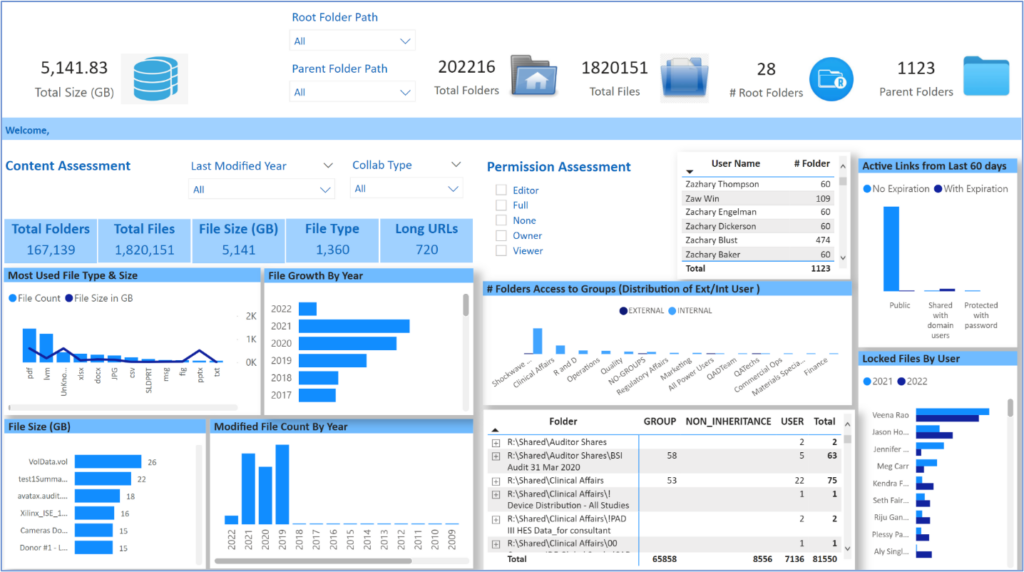Introduction:
Many organizations are looking to replace their legacy on-premises environments and platforms. But before we dive into how to create an overall SharePoint on-premises to SharePoint online migration plan, let us first explore three important topics to consider for your pre-migration strategy.
The Content
Content size plays a crucial role in the construction of a successful Migration Strategy. What worked well for a 1 TB migration may not play well when the content size is huge like 20 TB!
The content size can be SMALL (less than 1TB), MEDIUM (anything between 1-20TB), and LARGE (>20TB). Categorizing content size allows companies to better understand key strategic points about file sizes, item count, list records etc. thereby giving a clearer picture of what can be expected at the target.
Gather Requirements
Gathering inputs from stakeholders who will be impacted by this migration is crucial.
- Stakeholders should be aware that not all features of the legacy system can be ported over to the new system. Often, some architectural changes are needed to deal with deprecated and added features of SharePoint Online. Educate stakeholders on the disparities between the two platforms and when it makes sense to introduce customization to overcome some of the differences, with a full understanding that with customization comes increased cost/time to complete the project.
- Custom solutions can be extremely critical to business owners and may not be supported as-is on the target platform. Review all custom solutions on the source systems with the key stakeholders and suggest alternate out-of-box features before trying to replicate any custom solution in the target system.
- Assess business owners’ requirements and estimate how much time is needed to prepare for the migration and adapt to any changing business processes.
- Know the organization; know its culture. Conduct surveys and collect feedback from the organization’s business owners/domain champions/influencers/stakeholders.
Make It Simple. Let the Data tell the Story
Data insights can help drive your Migration Strategy. Collect data from the source system and use visualizations from a tool such as Power BI to tell the story and help the key stakeholders better understand how the current system is being used.

Figure 1: Sample Inventory Report
The Migration Strategy
Once you understand the content, have reviewed the requirements and explored migration options, you can start to formulate a migration strategy.
- What content are you migrating and how much? Have you defined the scope?
- Are the impacted departments/stakeholders aware of the migration? Create a timeline and a communication plan.
- Are users comfortable using the target platform? Create an adoption and change management (ACM) plan and involve subject matter experts from both the business and migration team using a train the trainer approach.
- Perform a migration mapping with complete documentation that has been vetted by the business owners.
- Create Proof of Concepts to demonstrate any new features
- Estimate the project timeline, considering both out-of-box and custom solutions needed for the target platform.
- Ensure that content to be migrated adheres to SharePoint limitations, such as item counts in a library, file size, long URLs, special characters, etc.
- Summarize and communicate all migration strategy decisions in a formal document and review it with the business owners.
- Conduct a test migration and review the results with the business owners before performing the full migration.

Ebook : 10 most important issues and how to solve them when migrating to SharePoint Online today!
Whether you are a business leader, IT professional, or end-user, the Netwoven SharePoint migration eBook can educate you on the benefits and opportunities of migrating to SharePoint on the cloud. Download it today!
Get the eBookProject Phases and Tasks:
Successful migrations follow a structured approach where key deliverables are defined for each major project phase.
| Project Initiation | Onboarding & access Kick-off Project initialization infrastructure Readying customer environment (VPN, servers, accounts etc Deliverable: Kick-Off Deck Deliverable: Project Plan |
| Migration Assessment | Identify Use cases of content Identify scope of the Project Create Content Inventory Report and Analysis Deck Identify use cases for Test Migration Deliverable: Decision To Make Workbook Deliverable: Content Inventory Report |
| Evaluation & Planning | Finalize Requirements / Decisions made Define / document / approve Migration Strategy Validate implementation plan Deliverable: Migration Strategy Document Deliverable: Implementation Plan |
| Migration Workshops | Target storage containers and options workshop Information Architecture and Permissions planning Migration tooling, strategy, and mapping workshop Adoption and Change Management framing Deliverable: Workshop Decks |
| Test Migration Bridge | Create prototypes in M365 for test migration Conduct Test Migration Validate and remediate issues Deliverable: M365 Test Migration Sites |
| Project Implementation | Input: Migration mapping Migration Timeline and Plan Test cases UAT Deliverable: Migration Plan Deliverable: Test Reports and Migration Status |
Figure 2: Sample project plan with deliverables
Here are some final takeaways to consider when planning your migration:
- Migrations are often phased and require flexibility. Technology should not be the key driver beyond your migration decisions.
- Migrations are often iterative – requiring a need to iteratively plan, execute, and release. Your migration approach will determine how much iteration is required.
- Be prepared for errors due to differences in the source and target platforms.
- Inventory and define what will be removed, transformed, or modified.
- Communicate changes early and often to key stakeholders and ensure that they are aware of what is coming next.
- A cohesive adoption and change management strategy is important for a successful migration.
We hope you found this blog useful in learning more about planning for SharePoint online migration. Please reach out to us so that we can put our decades of SharePoint migration experience and capabilities to work for your organization’s Digital Transformation.




![[With Solutions] 7 Key Challenges for Google Drive to SharePoint Migration](https://netwoven.com/wp-content/uploads/2024/05/gdrive.png)
















